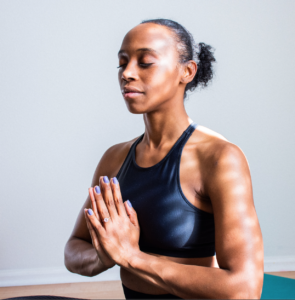A powerful yet simple guide to mastering a modern-day meditation practice.
Why Meditate?
Through daily meditation practice, we can lower our stress levels, improve our focus, connect with others, reduce mindless thought patterns, and live in the present moment.
Most articles about meditation are too abstract and difficult to understand.
They focus on the teachings of monks & gurus from thousands of years ago who live outside of the everyday life you and I are present in. Even worse, they can contain too much information that drowns out the true and simple nature of modern meditation practice.
So today we are going to take a different approach. Instead of listing the hundreds of different methods, ideologies, and tools, we are going to focus on the 5 most essential steps to a simple, daily, meditative practice.
I will fully break down each step and show you what my practice looks like along the way.
What Exactly is Meditation?
At its core, meditation is a form of mental exercise. It’s a way to practice being fully present and engaged with whatever we are experiencing in the moment.
It’s not about controlling the mind but rather taking a back seat and observing thoughts & emotions from a non-judgemental place.
From this place, we can see our thoughts for what they are and allow them to pass by like clouds on a warm sunny day.
What Are the Benefits of Meditation?
- Reduce negative states such as stress, anxiety, and depression
- Increase mental clarity and critical thinking
- Be more fully present in the moment without distraction
- Enhance self-awareness
- Generate kindness and compassion for others
- Cultivate a more positive outlook on life
- Reduce age-related memory loss
- Lengthen attention span
- Decrease blood pressure
- Help to regulate sleep patterns
Sounds pretty great right? The best part is, it’s just like any other skill set; once you learn, you can practice on your own for life.
So, what are these 5 simple steps to a modern meditation practice?
Let’s dive in…
1. Setting
Choose a place in your home that can be your regular meditation location. Coming back to the same area regularly will help you to develop the mind’s habit of getting into the mood to meditate.
You want this place to be dark, quiet, and where you will not be disturbed. Keep a watch or timer nearby to notify you when your meditation is complete.
I keep it simple and meditate every morning on my bed. I usually wake up and perform a few tasks before I begin my meditation to ensure I’m fully awake (brush teeth, drink water, move around). This helps keep me from falling asleep when I get back in bed to begin my practice.
I try not to check my phone or email before I’ve had the chance to sit in meditation as it would add more input to my mind which defeats the purpose. I use foam earplugs and an eye mask to ensure nothing can bother me.
2. Position
 Finding the right position & posture is key to a successful practice. You do not want to put yourself into any type of pain as that would draw your attention away from your breath (more of that on step 3).
Finding the right position & posture is key to a successful practice. You do not want to put yourself into any type of pain as that would draw your attention away from your breath (more of that on step 3).
I use 4 pillows during my practice to avoid any pain so I can fully focus on meditation. Sitting cross-legged on the mattress with my back against the headboard is my preferred position.
I sit on top of one pillow and place a second behind the curve in my lower back so I don’t hunch over. The other 2 pillows I place underneath my knees to avoid any joint pain.
There are many positions so if one doesn’t work best for you, keep experimenting until you find the right combination. Sonima wrote a great post on some of the different positions you can try.
3. Breath
Once you are set up in a comfortable position we can move into the next phase which is to focus on the breath. You will breathe in through the nose and out through the nose at your natural pace.
Try to focus on the area where the air enters your body. It could be the nostrils, upper lip, back of your throat, chest, or belly. It’s entirely up to you on what feels right.
As you are breathing and focusing on this area of the body you will notice thoughts start to arise in the mind. As they arise simply acknowledge their existence and gently bring your attention back to the breath.
breathe > thought arises > observe thought > return focus to your breath
After repeating for a few minutes you will begin to notice longer breaks between your thoughts. You are on the right track. The longer you focus on your breathing, the more frequent you will experience these moments without thought.
As you continue focusing on your breath, the endless thought stream of the mind will begin slowing down. Keep going. You will begin to feel a deepening sense of awareness.
4. Be Gentle with Yourself
 Remember to be gentle with yourself. Meditation is a practice and not something that can be attained, won, or earned.
Remember to be gentle with yourself. Meditation is a practice and not something that can be attained, won, or earned.
Also, there is no such thing as a good meditation session or a bad one. Each time you sit is an opportunity to check in with yourself and observe your thoughts and emotions.
There will be times when it’s hard to focus and it can feel like the thoughts never stop coming. Know that this is perfectly normal and it is okay! — You’re just observing.
I still have plenty of days when no matter what I do, I just can’t seem to get my mind to calm down. We all have crazy things going on in our lives… problems that need solutions. And our mind is really just trying to help. So there’s no need to beat ourselves up for trying.
“Be gentle with yourself. You are a child of the universe, no less than the trees and the stars. In the noisy confusion of life, keep peace in your soul.” – Max Erhmann
During these difficult practices, the best thing you can do for yourself is to sit for the full amount of time you have set for yourself.
By doing so, you create a habit of persistence, even on the tough days, which will positively transform your practice in the long run. And that brings us to our next point!
5. Daily Practice
Like anything, the more you practice, the better you will become. Persistence is absolutely key in maintaining a meditative practice.
We all have busy schedules but if you don’t have time for 5 minutes to stop and breathe, you are missing out on a lot that life has to offer.
I try to sit twice per day. Always in the morning for 20 to 30 minutes. I feel the mind is most fresh and available to go deep into meditation before I start ingesting lots of food, media, attention, etc.
I then sit for a second time for at least 10 minutes sometime during the day or before I go to bed. Meditating before bed can help slow the gears of the mind down to help get your brain ready to be put to sleep.
Meditation is a Skill
Meditation is something anyone can practice to enhance their emotional & mental health. It can be done anywhere without classrooms, special equipment, or spiritual teachers.
As you are meditating please remember that meditation is a skill that requires constant practice. It’s called a “practice” for a reason. There is no fixed destination and no end goal. It’s all about the process of going deep within oneself to discover who you truly are.
At first, you may feel that “it’s not working” or “I’m no good at this” but stick with it and work through those feelings. And when this happens, you simply take a step back and observe these thoughts and you will see that is exactly what they are; Just thoughts!
This deep realization will help you to continue the practice even on those tough days where it feels like your mind will not quiet down to matter what you do.
You are worth it.

3 thoughts on “5 Steps to Create Your Own Meditation Practice”
Wonderful article….calms me down just reading it!!! I am worth taken the time to meditate!!! Thank you for this article it was So Informative!!! Namaste
Very inviting, reassuring and concretely helpful article.
Jace, Your article on Meditation introduces a way for the newcomer to really understand and grasp the healing benefits of Meditation. In a simple but poignant way you show the newcomer how to establish their own practice without getting to overwhelmed or confused with the diffident styles of Meditation. Thank You!